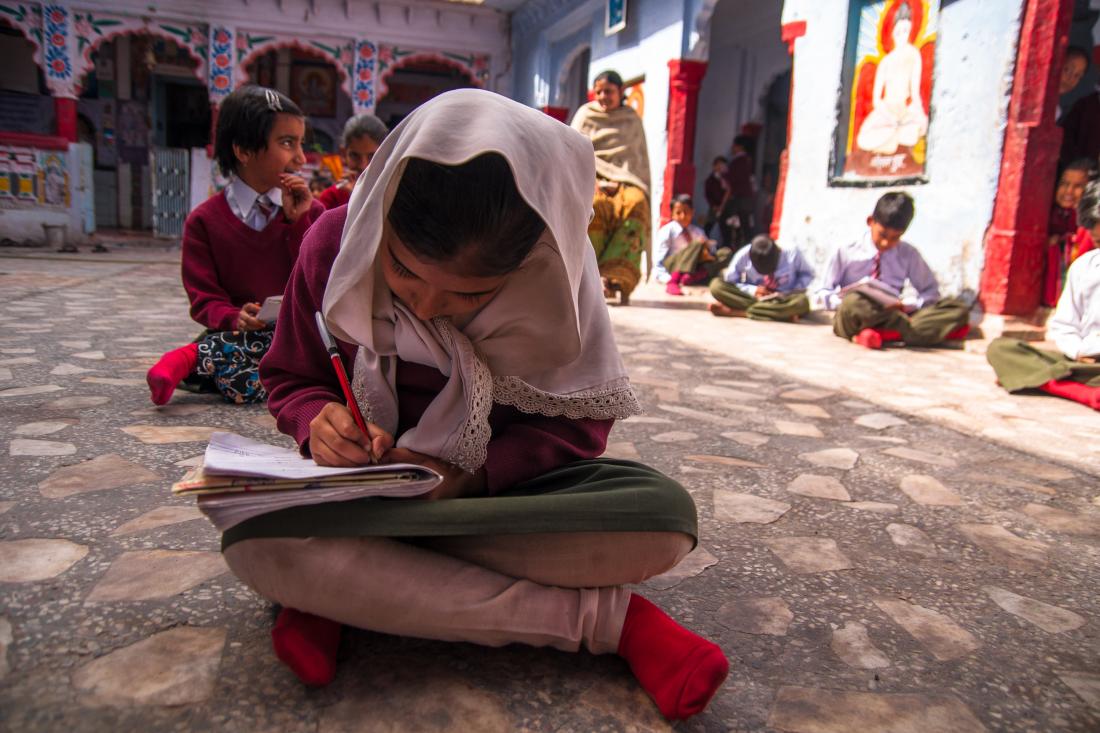The Impact of a Multifaceted Education Program on Student Learning and Enrollment in India
The Sustainable Development Goals set a triple educational objective: improve access to, quality of, and gender equity in education. In line with this goal, researchers conducted a randomized evaluation to measure the impact of a multifaceted educational program on school enrollment and learning in rural Rajasthan. Results showed that the program increased girl’s enrollment in the first and second years reducing the gender gap in school retention. Boys and girls both had improvements in learning in the first year.
Policy issue
The United Nations’ Sustainable Development Goal 4 proposes that by 2030 “all girls and boys complete free, equitable, and quality primary and secondary education.” This ambitious goal sets a triple objective for educational policies: improving free access to, equity in, and quality of learning. However, existing education evaluations tend to only assess the impact of one input at a time. To address this evidence gap, researchers implemented a multifaceted education program with multiple objectives in India to enroll marginalized girls and improve student learning. Can a program with multiple objectives achieve both goals at the same time?
Context of the evaluation
In Rajasthan, India, as of 2011, only 48 percent of students in grades 3–5 were able to read a grade 1 text in public schools, and only 33 percent were able to do subtraction. Furthermore, almost 5 percent of girls aged 7–10 did not go to school, more than double the number of out-of-school boys. This gender gap in schooling widens as children get older, often due to cultural and social norms such as marriage. As of 2012, 57.6 percent of women were married before the legal age. To address this issue, in 2012 Educate Girls, an Indian-based NGO introduced a multifaceted education program: door-to-door campaigns, training volunteers to teach activity-based and playful learning, and working with members of the community to promote girls’ education.

Details of the intervention
Researchers conducted a randomized evaluation to test the impact of a multifaceted education program on student enrollment and learning in Rajasthan, India. The evaluation was conducted in 230 primary schools in 98 villages. Using a random number generator, researchers assigned 49 villages (117 schools) to the treatment group and 49 villages (113 schools) to the comparison group. Schools in the treatment group received a combination of the following interventions:
- Door-to-door enrollment drive for girls: The ultimate goal was to increase enrollment of drop-out or never-enrolled girls by motivating them to come to school and encouraging parents to support their daughter’s education. To identify the targeted girls, NGO Educate Girls used data from the state government Child Tracking System (CTS) and school records. The visit was organized by the NGO, together with village leaders and community members.
- Interactive English, Hindi, and Math lessons for grades 3-5: Designed in partnership with Indian NGO Pratham and led by volunteers, the lessons emphasized group work and playful learning through games for boys and girls. Students received about 2 hours of instruction during the school day, several days per week, over 4-5 months. Furthermore, to see whether the program had any effect on the various levels of performance, students were divided into three groups according to their ability, which was measured in advance using pre-program tests.
The intervention was conducted from 2011 to 2014. Researchers measured the impact of the program on student enrollment and learning, and whether or not the program had different effects on girls and low-performing students.
Results and policy lessons
The program significantly increased girls’ enrollment in the first and second years. and learning in the first year. However, results did not persist into the second year.
Enrollment: There was a significant increase in girls’ enrollment in the first and second year. Girls’ enrollment increased by 0.684 students, the equivalent of an 8.1 percent rise from 2011 girls’ enrollment. In the second year, the effect on girls’ enrollment was even larger, amounting to 11.7 percent or an increase of 0.887 students. There was no significant difference between impacts on boys and girls. Researchers also found an increase in retention among girls: the program’s effect on enrollment was not only driven by new students, but also by more girls staying in school.
Learning: There was a significant gain in scores among both boys and girls on tests covering Hindi, English, and Math in the first year. Students who received the multifaceted program performed 0.32 standard deviations higher than those in comparison schools and were 22.7 percentage points more likely to improve from the pre-program test, with no differences by gender. Students with higher pre-program test scores experienced greater learning improvements than students with lower pre-program test scores. This suggests that low-performing students did not benefit from the program.
There was no significant impact on learning in schools that received the multi-faceted program in the second year. Researchers suggest this may be due to political economy factors. For instance, in the second year, volunteers were not paid but were offered future employment opportunities by the NGO. As a result, volunteers may have put in more effort during the first year, but experienced lower motivation in the second year. Moreover, larger class size in the second year may have reduced the program’s effectiveness, and this may be coupled with learning losses over school vacation.
These results suggests that programs aiming to improve both access and learning may achieve their objectives if supported by an adequate education policy. However, researchers suggest additional research on the effectiveness of interventions targeting (i) enrollment only, (ii) enrollment and learning through additional inputs, and (iii) enrollment and learning through need-tailored curricula.
Delavallade, Clara, Alan Griffith and Rebecca Thornton. “Effects of a Multi-Faceted Education
Program on Enrollment, Equity, Learning, and School Management Evidence from India”. Policy Research Working Paper 9081, December 2019.
